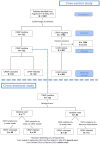Comorbidities and disease severity as risk factors for carbapenem-resistant Klebsiella pneumoniae colonization: report of an experience in an internal medicine unit
- PMID: 25335100
- PMCID: PMC4198186
- DOI: 10.1371/journal.pone.0110001
Comorbidities and disease severity as risk factors for carbapenem-resistant Klebsiella pneumoniae colonization: report of an experience in an internal medicine unit
Abstract
Background: Carbapenem-resistant Klebsiella pneumoniae (CRKP) is an emerging multidrug-resistant nosocomial pathogen, spreading to hospitalized elderly patients. Risk factors in this setting are unclear. Our aims were to explore the contribution of multi-morbidity and disease severity in the onset of CRKP colonization/infection, and to describe changes in epidemiology after the institution of quarantine-ward managed by staff-cohorting.
Methods and findings: With a case-control design, we evaluated 133 CRKP-positive patients (75 M, 58 F; mean age 79 ± 10 years) and a control group of 400 CRKP-negative subjects (179 M, 221 F; mean age 79 ± 12 years) admitted to Internal Medicine and Critical Subacute Care Unit of Parma University Hospital, Italy, during a 10-month period. Information about comorbidity type and severity, expressed through Cumulative Illness Rating Scale-CIRS, was collected in each patient. During an overall 5-month period, CRKP-positive patients were managed in an isolation ward with staff cohorting. A contact-bed isolation approach was established in the other 5 months. The effects of these strategies were evaluated with a cross-sectional study design. CRKP-positive subjects had higher CIRS comorbidity index (12.0 ± 3.6 vs 9.1 ± 3.5, p < 0.0001) and CIRS severity index (3.2 ± 0.4 vs 2.9 ± 0.5, p < 0.0001), along with higher cardiovascular, respiratory, renal and neurological disease burden than control group. CIRS severity index was associated with a higher risk for CRKP-colonization (OR 13.3, 95% CI6.88-25.93), independent of comorbidities. Isolation ward activation was associated with decreased monthly incidence of CRKP-positivity (from 16.9% to 1.2% of all admissions) and infection (from 36.6% to 22.5% of all positive cases; p = 0.04 derived by Wilcoxon signed-rank test). Mortality rate did not differ between cases and controls (21.8% vs 15.2%, p = 0.08). The main limitations of this study are observational design and lack of data about prior antibiotic exposure.
Conclusions: Comorbidities and disease severity are relevant risk factors for CRKP-colonization/infection in elderly frail patients. Sanitary measures may have contributed to limit epidemic spread and rate of infection also in internal medicine setting.
Conflict of interest statement
Figures



References
-
- Nordmann P, Poirel L (2002) Emerging carbapenemases in Gram-negative aerobes. Clin Microbiol Infect 8: 321–331. - PubMed
-
- Cornaglia G, Giamarellou H, Rossolini GM (2011) Metallo-β-lactamases: a last frontier for β-lactams? Lancet Infect Dis 11: 381–393. - PubMed
-
- Lomaestro BM, Tobin EH, Shang W, Gootz T (2006) The spread of Klebsiella pneumoniae carbapenemase-producing K. pneumoniae to upstate New York. Clin Infect Dis 43: e26–e28. - PubMed
MeSH terms
Substances
LinkOut - more resources
Full Text Sources
Other Literature Sources

